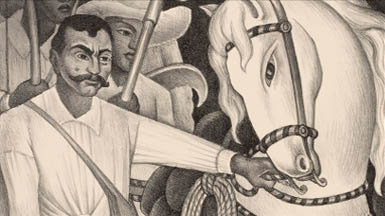Revolution on Paper
dal 21/10/2009 al 4/4/2010
Segnalato da
21/10/2009
Revolution on Paper
British Museum, London
Mexican Prints 1910 - 1960. Some of these prints were produced by the 3 artists known as 'los tres grandes': Diego Rivera, Jose' Clemente Orozco and David Alfaro Siqueiros. Printmakers in Mexico often belonged to groups, societies and movements which were underpinned by their commitment to politics. The earliest movement was Stridentism, an avant garde group which was launched 1921 and that rejected the past. In the exhibition many other artist are involved and the range of material is fascinating: single-sheet prints, posters, and illustrated books on many different themes.

The exhibition will be the first in Europe focusing on the great age of Mexican printmaking in the first half of the twentieth century.
Between 1910 and 1920 the country was convulsed by the first socialist revolution, from which emerged a strong left-wing government that laid great stress on art as a vehicle for promoting the values of the revolution. This led to a pioneering programme to cover the walls of public buildings with vast murals, and later to setting up print workshops to produce works for mass distribution and education. All the prints in the exhibition come from the British Museum’s collection which has been acquired thanks to the generosity of the Aldama Foundation, Dave and Reba Williams and The Art Fund.
Some of the finest of these prints were produced by the three great men of Mexican art of the period known as ‘los tres grandes’: Diego Rivera, José Clemente Orozco and David Alfaro Siqueiros. The best-known print is Rivera’s Emiliano Zapata and his horse which has achieved iconic status in twentieth century Mexican art. Other prints including Rivera’s portrait of Frida Kahlo, Siqueiros’ Dama Negra, Orozco’s The Masses, demonstrate the extraordinary breadth, imagination, and quality of the works shown. In addition to the Los Tres Grandes, many other artist were involved and rose to prominence, especially after the founding of the Taller del Gráfica Popular (TGP) in Mexico City in 1937. The range of material is fascinating: as well as single-sheet artists’ prints, there are large posters with designs in woodcut or lithography by these same artists, and illustrated books on many different themes. The exhibition will also include earlier works around the turn of the century by the popular printmaker, José Guadalupe Posada, who was adopted by the revolutionaries as the archetypal printmaker who worked for the people, and whose macabre dances of skeletons have always fascinated Europeans.
Printmakers in Mexico often belonged to groups, societies and movements which were underpinned by their commitment to politics. The earliest movement was Stridentism, an avant garde group which was launched 1921 and was similar to the Italian Futurist movement because it rejected the past. The Taller de Gráfica Popular (TGP) was formed in 1937 by Luis Arenal, Leopoldo Méndez and Pablo O’Higgins as a graphic arts workshop which was influenced by communism. TGP members had access to printing equipment at the workshop and did not need to have artistic training. The collective produced prints for posters, flyers and portfolios which were printed on cheap paper. Their prints often supported the campaigns of trade and workers unions in Mexico. For example, Pablo O’Higgins and Alberto Beltrán collectively made a poster advertising the first Latin American Petrol Workers conference. The TGP was also particularly committed to the fight against international Fascism. Angel Bracho’s striking red and black poster, Victoria! (1945), which celebrates the allied victory over the Nazi’s in 1945, is a key example of the TGP’s anti-Fascist stance. Other printmakers addressed subjects such as corruption, capitalism and Mexican daily life in their prints.
In 1957, the TGP held a major exhibition at the Fine Arts Palace in Mexico City to celebrate its twentieth anniversary as a printmaking collective and its activity continues even today on a minor scale. Members of the TGP and other artists’ groups have published extensively in support of the visual arts. Other artists associated with the TGP went on to establish art schools, institutions or museums.
The exhibition is supported by The Monument Trust and the Mexico Tourism Board. The exhibition will tour to three venues across the UK after it closes at the British Museum.
Image: Diego Rivera, Emiliano Zapata and his horse, 1932
For further information or images please contact Esme Wilson on +44 (0)20 7323 8394 or ewilson@britishmuseum.org
British Museum
Great Russell Street, London WC1B 3DG
The Museum is open every day 10.00–17.30
The British Museum is free to all visitors
A charge may be made for some special exhibitions



